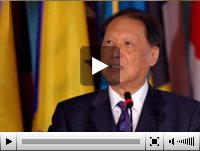- English
Lecture Series
Tenth Lecture - Cheng Siwei
Tenth Lecture - December 6, 2005
"China and Latin America and the Caribbean: A Promising Future"
Speaker:
Cheng Siwei,
Vice President of the National Congress of the People’s Republic of China
I am very glad to speak to you here today under three hats. The first is an official hat, Vice Chairman of the Standing Committee of China’s National People’s Congress; the second is an unofficial one, President of the China-Latin America Friendship Association; and the third an academic one, a scholar on economics. I look forward to discussing with you prospects for China-Latin America and the Caribbean relations and measures for greater cooperation between our two sides.
Sound Foundation for Political Cooperation
The Chinese Government has always attached importance to its relations with Latin America and the Caribbean countries, as evidenced by frequent personnel exchanges between our two sides. China’s state leaders have visited Latin America and the Caribbean on many occasions, a good example of which is Chinese President Hu Jintao’s visit to Argentina, Brazil, Chile and Cuba in November 2004. In January 2005, Chinese Vice President Zeng Qinghong visited Mexico, Peru, Venezuela, Trinidad and Tobago and Jamaica. In recent years, many heads of state/government from Latin America and the Caribbean have also come to China for visits. I myself have participated in the events held by former President Jiang Zemin and President Hu Jintao for visiting presidents from Latin America and the Caribbean countries, including Mexico, Brazil, Chile, Venezuela, Ecuador, Uruguay and Colombia. China’s NPC has maintained close contacts with many Latin America and the Caribbean parliaments. China is now an observer to the OAS and PARLATIMO and has ties with the Group of Rio, the Andean Community, CARICOM and Mercosur.
The foundation for political cooperation between China and Latin America and the Caribbean has three elements. First, both belong to the developing world and have identical or similar views on many issues. Second, both have a history of striving for national independence. I have seen in many Latin America and the Caribbean countries monuments to their heroes fallen in the fight for independence. Third, both China and Latin America and the Caribbean countries share the aspiration for maintaining world peace and promoting common development. Given the aforementioned three elements, China and Latin America and the Caribbean can further develop political cooperation on many issues. At present, China has diplomatic relations with 95% of Latin America in terms of land area, population and economic strength. China has established strategic partnerships with Brazil, Mexico, Argentina, established strategic partnership for common development with Venezuela, and actively develop all-round cooperation with other countries. China pursues a relationship of mutual political support and mutual trust with Latin America and the Caribbean countries, by which the two sides can further strengthen communications, coordination and cooperation on major issues bearing on world peace and development, democratization of international relations, and protection of the legitimate rights and interests of developing countries.
China is the largest developing country and a permanent member of the UN Security Council. Its peaceful development in recent years has attracted worldwide attention and its role keeps rising in world politics and economy. I hope that leaders from those few Latin America and Caribbean countries yet to establish diplomatic relations with China can see clearly the general trend of the world and develop cooperation with China on the basis of the universally recognized “one China” principle.
Big Potential for Economic Cooperation
After more than 20 years of economic reform and development, China has gradually raised its overall national strength and improved the livelihood of its people, which is a success recognized by all. Since the reform and opening up policy was inaugurated in 1978, over a long span of 20-plus years, China’s economy has been growing at an annual rate of over 9%. In 2004, China’s GDP reached US$ 1.65 trillion, the world’s Number Six; its foreign trade volume, including imports and exports, totaled US$ 1.15 trillion, the world’s Number Three; it attracted US$ 60.6 billion in FDI, the world’s Number One; and its foreign exchange reserve registered US$ 609.9 billion, the world’s Number Two. On the one hand, China’s great aggregate economic strength makes it possible to carry out manned space flight, a task hard to accomplish even too many developed countries. On the other hand, China must work still harder and develop faster since its per capita GDP is only US$ 1,290, lower than that of many Latin America and the Caribbean countries, given China’s 1.3 billion people.
Latin America and the Caribbean presents tremendous potential for development as it has vast territory, large population, fertile land and abundant resources. Despite past economic setbacks, many Latin America and Caribbean countries have experienced recovery in the past two years. In 2004, the Latin America and Caribbean economy increased by 5.5%, the fastest growth over the last 20-plus years. According to a research report issued by the UN Economic Commission for Latin America and the Caribbean on August 3 this year, the economy of Latin America and the Caribbean is expected to grow by around 4.3% and 4% respectively this year and the next year. Of course, Latin America and the Caribbean countries also have problems such as fragile economic base, irrational economic structure, over-dependence on foreign trade, heavy external debt burden and big poor population, all of which need to be dealt with seriously.



